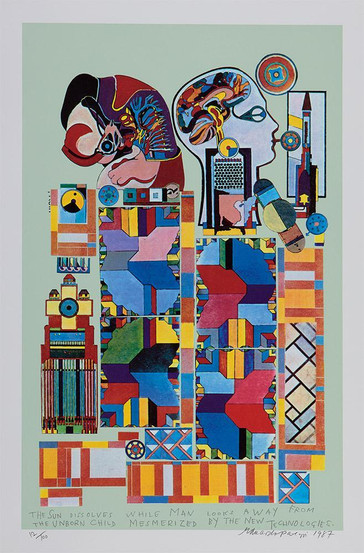One of the founders and pioneers of the British pop art and surrealist movements. A dynamic multi-disciplined polymath who wanted to break the barriers of artistic categorisation. An influential and innovative artist who was truly ahead of his time and managed to leave an indelible mark on British Culture.

As an artist, Eduardo Paolozzi was always restless and experimental, he was constantly zig-zagging between styles, forms and mediums with ease while being constantly innovative. Fascinated by Sci-fi, modern technology and machines, this British artisans' plethora of work redefined the boundaries of art, design and advertising, his dynamic career saw him combine graphic design, textiles, photography, collage, print making, mosaics, pottery, film and sculptures into his own idiosyncratic brand of British surrealist pop art. Eduardo's veracious appetite for vibrant and indelible imagery is what paved the way for his infinite variety and creative audacity as a multi-talented artist.

Sir Eduardo Luigi Paolozzi was born March 7th, 1924, as the eldest child of two Italian immigrants who migrated from the remote province of Frosionone to the port district of Leith in Edinburgh, Scotland.

His parents ran an ice cream parlour in Leith, which is were Eduardo grew up as a child, surrounded by the vibrant pop art advertisements and mesmerising multi-coloured product designs of the family's business. All this imagery had a profound impact upon Eduardo, he was so inspired by his environment as a child that he became an avid illustrator, he loved drawing so much that he aspired to become a commercial artist himself.

Eduardo Paolozzi's other passions included collecting ephemera, science fiction magazines, old comics, discarded toys, anything that could be incorporated into his work. This was the start of his lifelong passion for collecting and repurposing found objects and images into his artwork.
Two of Eduardo's earliest advertisement experiments include I was a Rich Man’s Plaything (1947), and Meet the People (1948). These collage pieces were crafted from magazines given to Paolozzi by American ex-servicemen. These collages display his fascination with the over-saturated glamour of American post-war consumerism, pop culture and technology. All of these crucial stylistic elements would become an integral part of the artist's on-going creative practice and artistic output, which led to Eduardo kickstarting the British Pop Art movement in 1952.

Paolozzi was one of the very few British artists who achieved international acclaim after the events of the Second World War. Eduardo's career was incredibly ambitious, he worked in a way that was new, revolutionary and technological. He continued elevating himself until his work was firmly establish on the cultural radar, driven by his determination to solidify his name as an artist in a country which never truly felt like home. One of his first masterpieces was the "Whitworth Tapestry", one of the most meticulously crafted and imaginative examples of textiles in the 1960's.

In the 1960's, Eduardo began using his artwork as a vehicle to explore the pertinent issues of the times, covering mass media, corrupt politics and vapid celebrity culture. All of these influences and subject matters resulted in the screen print series "As is When", thirteen unique prints dedicated to the life of the philosopher Ludwig Wittgenstein, which is often cited as one of the finest examples of screen printing in the 20th century.

The reason these prints are so exceptional and innovative is because Paolozzi was experimenting with screen print making techniques that were normally restricted and were in limited use for commercial advertisements and industrial purposes, he chose to adopt and transform these factory printing techniques and made it into a fine art application, his screen prints from this time period combine collage, textile, photos and graphics.
~ Take a journey through Paolozzi's "AS IS WHEN" series ~
In the 1970's, Eduardo's pioneering pop-art aesthetic became even more psychedelic, imaginative and multi-faceted. Eduardo's stunning geometric collaged screen prints began delving deeper into the realms of science fiction and artistic futurism, while still retaining his curiosity for the vibrancy of popular culture and the glossy colourful deception of celebrity, an image which he masterfully deconstructed and repurposed for his print designs. Eduardo was an artist whose work embraced the beauty and mystery of technology rather than demonising it as something to be feared.
~ A Gallery og Eduardo's 1970's SCI-FI-O-RAMA prints ~
As Eduardo's career continued evolving and innovating throughout the 1980's and 1990's, his vast and imposing body of work began to encompass more mediums, styles and techniques. Eduardo was becoming more fascinated with designing and producing architecture, mosaics, pottery and sculptures inspired by industrial engineering. Eduardo's most famous sculpture is his 12-foot bronze sculpture of Issac Newton, designed in 1995 and depicting Newton as an iron giant in the search for knowledge, his body resembles a big mechanical object, joined with bolts at the shoulders, elbows, knees and ankles, displaying the duality between science and nature. This six-tonne sculpture is displayed on a plinth outside the British Library in London and was originally inspired by William Blake's watercolour "Newton", in which Newton is surrounded by the glorious beauties of nature but is oblivious to it all, deep in his quest for knowledge.


Eduardo was extremely successful in establishing his name and work as an artist in the UK, his artistic output has found it's place among the heart of everyday life, in places of movement, commerce and transportation. Paolozzi's influence and creative impact can be seen everywhere across the capital of London, most notably in the Tottenham Court Road station, where you can find his vast multi-coloured glass mosaic designs spread along the station's Northern and Central Line platforms and walkways.
This commission was complete in 1986, and features all of the captivating patterns and vivid colours and motifs of Eduardo's famous screen printing work, converted and transformed into a 950 metre mosaic tapestry, a bright and vibrant palace of pop art images that mirrors the ever evolving relationship between mankind and machine imagery. A perfect artistic statement to make down in the labyrinths of the London Underground, where interconnected figures and shapes are in constant motion, the flow and colours of people rushing to make their way to their own destinations.

Many admirerers of Eduardo Paolozzi's work may not be aware that he also experimented with filmmaking and animation. The earliest surviving film by Eduardo Paolozzi is entitled 'History of Nothing' from 1962 and 'Kakafon Kakkoon' 1965. In these animations, the unlikely juxtapositions of found images and bizarre sounds reflect Paolozzi’s view that juggling different materials and ideas is the very essence of the creative act. In their different ways, the two films strongly portray the modern and mechanised world, in which everything is connected and constantly changing.
~ Psychic Garden





















































Comments